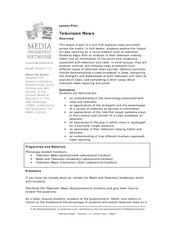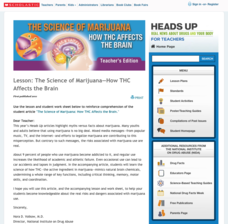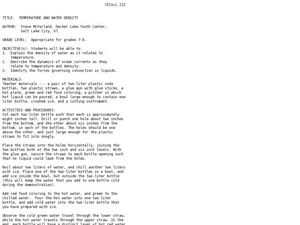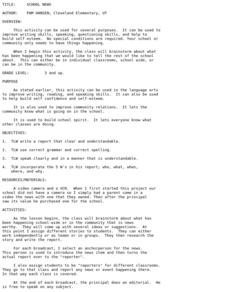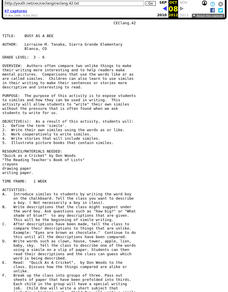Northern Lights Special Education Cooperative
Lessons from The 7 Habits of Highly Effective Teens
As part of a study of Sean Covey, the author of The 7 Habits of Highly Effective Teens learners write autobiographical e-mails, hold discussions, create a collage, and compose a personal mission statement. Pupils then have a chance to...
Healthy Native Youth
Chapter 2: Learning About Adolescence
The Native American symbol, The Circle of Life, represents life's spiritual, physical, mental, and emotional well being. By way of deep discussion, and two games, the lesson uses the Circle of Life to explore the stages of maturity,...
PBS
Cloud Clues
It's cloudy with a good chance of learning! An inquiry-based lesson begins with an exploration of transparent, translucent, and opaque materials. Young scientists then connect their learning to the different cloud types as they take the...
Curated OER
Communicating:A Two-Way Need
Students engage an older adult in one-to-one contact. They develop communication skills that can be used in future interactions. They complete a handout and interview one older adult. They examine what society needs to do to help...
Curated OER
Entrepreneur: Serving the Mature Adult
Tenth graders recognize the needs of older consumers for certain products. They apply creativity skills to develop a product that meets the needs of older consumers. In the end, they do a verbal presentation for a group of older consumers.
Curated OER
Asian Rhythms
Students experience another culture through a unit that explores instruments, spoken language, and calligraphy. Students experience the Asian culture first hand through a Taiko Drum Concert, as well as lunch at an Asian Buffet &...
Curated OER
Quiet on the Set!
In pairs learners perform a silent skit portraying relationships between two known characters from a popular book or a play for their classmates. Next, the class will read and discuss a NYTimes article about a film school in the Bronx...
Curated OER
Smoking Today = Smoking Tomorrow
Examine statistical data to recognize the relationship of statistics to real-world issues. Pupils navigate e-stat using the Internet and find data about social issues. They complete a worksheet with their data and create an anti-smoking...
Curated OER
Getting and Keeping a Job for Teens
Your 16 or 17-year-old young scholars really want to get a job. Show them how to find a job opening, choose a job, and pick up a job application. They'll create a list of where to find job opening information, fill out a job application,...
Curated OER
Television News
Different media sources portray news in a variety of ways. In groups of three, learners look at different news sources, bringing in all the findings the next day. Three handouts help scholars compare sources, define specific terms used...
PwC Financial Literacy
Charitable Giving
Charitable organizations and monetary donations to these organizations are the focus of the financial literacy lesson plan presented here. Learners explore how donations benefit both the organization and the people it serves. Each pupil...
PwC Financial Literacy
Insurance Why's and How's
Middle schoolers explore the primary purposes of a variety of types of insurance. They determine who benefits the most from insurance coverage, and examine the factors that lead to increases and decreases in insurance premiums. The...
Annenberg Foundation
Making an Issue-Based Video
Encourage class members to become engaged citizens by researching an issue they are passionate about and then producing a video to present to policymakers, the public, and their peers. Everything needed for the unit is contained in...
Classroom Law Project
How do we hire a President?
What are the job requirements for the office of president of the United States? What attributes should a candidate possess? Are the qualities needed to govern the same as those needed to win? What can an analysis of the management style...
PACER Center
The Peer Advocacy Guide
Teasing, mocking, and disrespect can be the hallmarks in the life of those with disabilities. Disrupt the cycle of abuse with a toolkit designed to turn peers into advocates for all those who are bullied. Everything needed to create a...
PBS
The Sixties: Dylan Plugs in and Sells Out
Before Woodstock, there was Newport. Get plugged in to the social changes of the 1960s with a lesson that looks at Bob Dylan's performance at the 1965 Newport Folk Festival as a symbol of the radical changes that marked the era.
Scholastic
The Science of Marijuana—How THC Affects the Brain
Marijuana can affect every part of a user's life—starting with the delicate nervous centers of the brain. An informative article and worksheet prompt teenagers to learn more about how the THC found in most forms of marijuana can...
Curated OER
Wood Identification Based on Density
Eighth graders measure irregular and regular shaped solids. In this investigative lesson students calculator volume, mass and density of wood and blocks.
Curated OER
Temperature and Water Density
Students consider the effects of temperature on water density. In this Earth Science lesson, students evaluate a demonstration of cold and hot water currents in a model. Students use two liter bottles and varied water temperatures with...
Curated OER
Vocabulary Building - Brainstorming
Students learn new vocabulary words in ways that are fun and enriching. They brainstorm lists of words to be used in sentences, stories, or conversations.
Curated OER
The Little Red House
Students develop the first developmental skill in Gross Motor Coordination, Fine Motor Coordination, Auditory, Language, and Visual areas using the story "The Little Red House."
Curated OER
THE FLIGHT PLATFORM
Pupils examine forces that effect flight. In this flight lesson students answer questions that are asked of them and the ones that they ask themselves.
Curated OER
School News
Students create a video of school news to improve writing skills, speaking skills, questioning skills, and to help build self esteem.
Curated OER
Busy As a Bee
Students define the term 'simile,' write their own similes using the words as or like, and work cooperatively to write similes. In addition, students write stories that include similes and illustrate picture books that contain similes.











